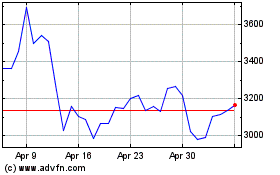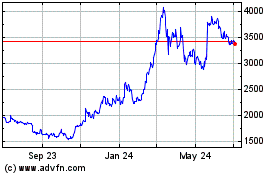Ethereum’s Block Size Surges To 1-Month High – What This Means For ETH
May 29 2023 - 12:25AM
NEWSBTC
Ethereum, the world’s second-largest cryptocurrency by market
capitalization, has witnessed a significant surge in its mean block
size, reaching a new 1-month high. This milestone was recently
announced by Glassnode, a renowned on-chain analysis platform. The
increase in block size indicates a notable improvement in
Ethereum’s network capacity and transaction throughput, potentially
bringing positive implications for the ecosystem. Breaking Down The
Block Size Surge The mean block size of Ethereum has skyrocketed,
surpassing the previous 1-month high recorded on May 27, 2023.
Glassnode’s data reveals that the current mean block size stands at
121.4 million. This surge highlights a substantial increase in the
average data volume accommodated within individual blocks of the
Ethereum blockchain. Related Reading: Gas Crisis Averted: NFT
Marketplaces Witness Dramatic Reduction in Ethereum Fees Larger
block size is indicative of Ethereum’s ability to handle more data
and transactions per block, effectively enhancing the network’s
capacity. With a higher average data volume in recent blocks, ETH
showcases its potential for improved scalability and transaction
throughput. Ethereum’s surge in block size signifies a positive
development for the ETH ecosystem, as it accommodates the growing
demands and usage of the network. What This Means For Ethereum The
surge in Ethereum’s mean block size holds several implications for
ETH and its community. Firstly, it signifies the network’s
continued growth and adoption. As more participants engage with the
Ethereum blockchain, the increased block size demonstrates the
platform’s ability to handle a higher volume of transactions,
leading to enhanced efficiency and reduced congestion. Moreover,
the surge in block size also contributes to improved transaction
throughput. With larger block sizes, more transactions can be
included in each block, resulting in faster confirmation times and
smoother user experiences. This development is crucial for
applications built on the Ethereum network, such as decentralized
finance (DeFi) protocols, non-fungible token (NFT) marketplaces,
and various other decentralized applications (dApps). It enables
them to process a greater number of transactions within a given
timeframe, fostering better scalability and usability.
Additionally, Ethereum’s increased block size may have a positive
impact on gas fees. Gas fees, which are transaction fees on the
Ethereum network, can be influenced by block size. A larger block
size allows for the inclusion of more transactions, potentially
alleviating congestion and reducing gas fees. This could lead to a
more cost-effective and accessible environment for users and
developers utilizing the Ethereum ecosystem. Related Reading:
Crypto Expert Predicts Ethereum (ETH) To Reach $457,000 – Here’s
How Meanwhile, Ethereum has shown a possible brewing uptick in the
past week. The second crypto asset by market capitalization has
surged 2.3% in the past week. Over the past 24 hours, ETH has
seen a 1.1% gain. At the time of writing, Ethereum currently
trades at $1,851. Ethereum’s trading volume has, however, ranged
between $3 billion and $5 billion in the past seven days indicating
a possible accumulation. Regardless, in the past 24 hours, ETH has
had a trading volume of $5.5 billion. -Featured image from
Shutterstock, Chart from TradingView
Ethereum (COIN:ETHUSD)
Historical Stock Chart
From Mar 2024 to Apr 2024

Ethereum (COIN:ETHUSD)
Historical Stock Chart
From Apr 2023 to Apr 2024
